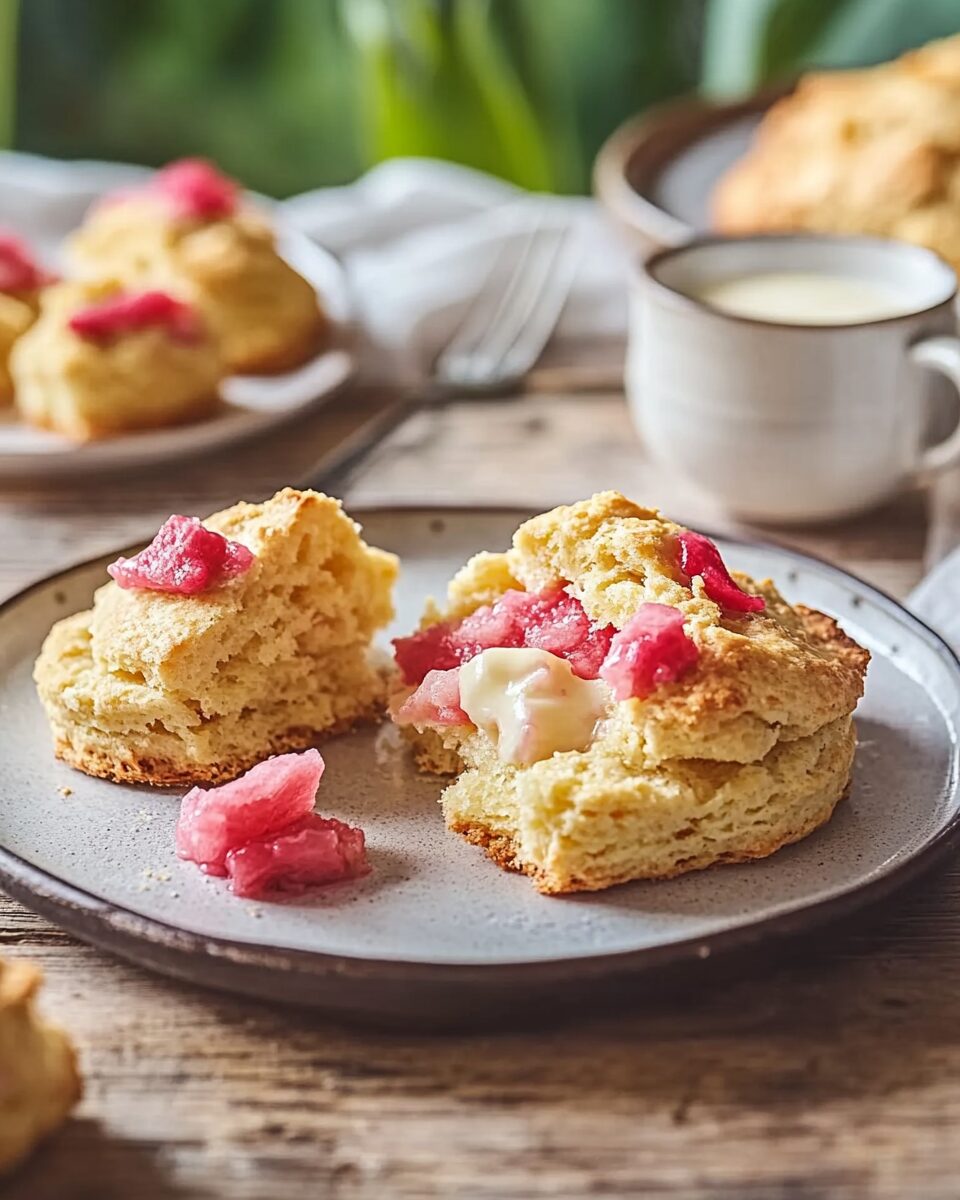These golden Rhubarb Custard Scones are a twist on a classic, marrying the comforting taste of creamy custard with the sweet sharpness of fresh rhubarb. Whether you’re serving them with clotted cream or enjoying them plain, they’re a celebration of British baking at its finest.
The soft, buttery texture paired with the vibrant compote makes them ideal for afternoon tea in the garden or a cozy weekend bake. They’re best enjoyed warm and fresh from the oven, and perfect for anyone looking to bake something nostalgic, yet a little different.
Full Recipe:
For the scones:
-
350g self-raising flour, plus extra for dusting
-
50g custard powder
-
¼ tsp fine salt
-
1 tsp baking powder
-
3 tbsp caster sugar
-
100g unsalted butter, chilled and cubed
-
175ml whole milk
-
1 medium egg, beaten (for glazing)
For the rhubarb compote:
-
300g rhubarb (fresh or frozen), chopped
-
50g caster sugar
-
½ tsp vanilla extract
-
2 tbsp water (omit if using frozen rhubarb)
-
Optional: drop of red food colouring for brighter color
To serve:
-
Clotted cream
Directions:
-
In a large mixing bowl, combine the flour, custard powder, salt, baking powder, and sugar.
-
Rub in the butter with your fingertips until the mixture resembles fine breadcrumbs.
-
Gradually add the milk and bring together with your hands to form a smooth dough. You might not need all the milk.
-
Lightly flour your surface and roll the dough to about 2cm thick. Transfer it to a baking tray lined with parchment and chill for 30 minutes to 1 hour.
-
Meanwhile, make the rhubarb compote: place rhubarb, sugar, vanilla, and water into a saucepan and simmer for 10-15 minutes until soft and thickened. If using frozen rhubarb, skip the water and optionally add food colouring. Allow to cool.
-
Preheat the oven to 220°C/200°C fan/gas 7.
-
Cut out 7cm rounds from the chilled dough and place them on a parchment-lined tray, spacing them 2cm apart.
-
Re-roll any scraps to get around 6 scones total.
-
Brush the tops with beaten egg and bake for 10–12 minutes, until golden brown.
-
Cool on the tray, then serve with rhubarb compote and clotted cream.
Prep Time: 30 minutes (plus chilling) | Cooking Time: 12 minutes | Total Time: 42 minutes
Kcal: ~280 kcal per scone | Servings: 6
A Traditional British Treat with a Modern Twist
Rhubarb custard scones are a delightful variation of the classic British scone, bringing together the comforting warmth of baked goods with the nostalgic flavor duo of rhubarb and custard. Scones have long been a staple of British tea culture, often enjoyed during “cream tea” — a tradition where warm scones are served with clotted cream and jam, typically accompanied by a pot of tea. This version elevates the experience by incorporating a rhubarb compote and custard flavor into the dough, creating a rich, fruity, and creamy blend that melts in the mouth.
The Inspiration Behind Rhubarb and Custard
The rhubarb and custard combination holds a special place in British culinary history. It was once a quintessential school dinner dessert, where tart rhubarb was tempered by a generous pour of silky vanilla custard. This comforting pairing became so iconic that it even inspired candies, ice creams, and various baked goods.
Bringing this nostalgic combination into scones not only appeals to those who grew up with it, but also introduces a new generation of bakers and food lovers to its charm. The sharpness of the rhubarb cuts through the richness of the scone, while the custard powder added to the dough lends a subtle vanilla aroma and tender crumb texture.
Rhubarb: A Star Ingredient with a Tangy Edge
Rhubarb is technically a vegetable, but in culinary contexts, it’s used more like a fruit. Its vibrant pink stalks and distinct tart flavor make it a favorite in spring and summer baking. In this scone recipe, rhubarb is cooked down into a compote, allowing it to soften and concentrate its flavor. A touch of sugar balances its acidity, while vanilla enhances its natural floral notes.
Using either fresh or frozen rhubarb is possible in this recipe, making it accessible year-round. However, when rhubarb is in season — typically between April and June in the UK — the flavor and color are at their peak. Some bakers even choose to add a drop of red food coloring to enhance the compote’s pink hue, especially when using frozen rhubarb, which can turn dull after cooking.
Custard Powder: The Unsung Hero of British Baking
Custard powder, though simple, has a magical way of transforming baked goods. Invented in the 19th century by Alfred Bird, custard powder was a solution for making eggless custard and has since become a pantry staple in many British households. It imparts a rich, vanilla-like flavor and gives baked goods a velvety texture.
In this scone recipe, custard powder is mixed directly into the dough, infusing every bite with its comforting flavor. It also slightly softens the structure of the scone, giving it a less crumbly and more tender texture — ideal for absorbing clotted cream or extra compote when serving.
Perfecting the Scone Dough
Scone-making is both an art and a science. The key lies in not overworking the dough. After combining the dry ingredients and rubbing in the butter to create a breadcrumb-like consistency, the milk is gradually added to bring the dough together. It’s important to handle the dough gently to avoid developing too much gluten, which could make the scones tough.
The dough should be chilled before baking, allowing the butter to firm up and the gluten to relax. This results in a higher rise and a lighter, fluffier texture. Once cut, the scones are brushed with egg for a golden finish and baked until just set, maintaining a soft interior and delicately crisp top.
Serving Suggestions: Cream Tea Elevated
The beauty of rhubarb custard scones is how versatile they are for presentation. Traditionally served warm with clotted cream and jam, this version already includes the fruit component in the form of rhubarb compote. Simply slathering on some clotted cream and a dollop of the homemade compote is enough to create a gourmet tea-time experience.
These scones also pair wonderfully with crème fraîche, Greek yogurt, or even a spoonful of whipped cream for those who prefer lighter options. A sprinkle of icing sugar before serving adds an elegant touch, while edible flowers can make the plate presentation garden-party ready.
For drinks, a strong English breakfast tea is the classic pairing, but herbal options like chamomile or mint can also enhance the flavors of the rhubarb. A glass of sparkling elderflower or prosecco wouldn’t go amiss if serving these at a brunch or celebratory occasion.
Storage and Make-Ahead Tips
While scones are best enjoyed fresh, these hold up reasonably well for a day or two if stored in an airtight container. The compote should be stored separately in the fridge, where it will keep for up to 5 days. Reheating the scones slightly in the oven or a toaster oven brings back their original warmth and fluffiness.
The dough can also be made ahead and chilled for up to an hour before cutting and baking. This is especially helpful when preparing for a brunch or afternoon tea gathering, as it allows you to serve warm scones without the last-minute kitchen rush.
A Versatile Canvas for Flavors
What makes this recipe exciting is how customizable it can be. Don’t have rhubarb? Try making the compote with strawberries, raspberries, or plums. Want an even more indulgent twist? Add white chocolate chips to the dough. Feeling adventurous? Infuse the compote with rose water or ginger for a more exotic take.
Likewise, the custard powder could be swapped for vanilla bean paste or even lemon zest to add a citrusy contrast to the rhubarb. These small tweaks allow the recipe to evolve with the seasons and the baker’s creativity.
Baking Tips for Best Results
To get the most out of your scones:
-
Use cold butter and cold milk. This ensures a flaky texture.
-
Don’t twist your biscuit cutter — it can seal the edges and prevent proper rising.
-
Bake scones close together for softer sides, or spaced apart for crispier edges.
-
Always brush the tops, not the sides, with egg wash. Brushing the sides can inhibit rising.
These small adjustments make a significant difference in the final result and help you create scones that are bakery-quality.
Why This Recipe Works
The success of rhubarb custard scones lies in the balance of flavors and textures. The scone itself is buttery and soft, with just enough sweetness to offset the tang of the rhubarb. The compote, with its syrupy consistency, adds both moisture and visual appeal. Meanwhile, the custard powder subtly lifts the flavor with nostalgic notes.
This recipe brings together texture (crumbly edges, soft interiors), flavor (tart, sweet, creamy), and aroma (vanilla and rhubarb baking together is divine), making it irresistible to anyone who loves a good baked treat.
Conclusion
Rhubarb custard scones are more than just a baked good — they’re a celebration of tradition and creativity, of past and present. Whether you’re preparing for a springtime afternoon tea or just want to treat yourself with something cozy and delicious, this recipe delivers comfort, beauty, and unforgettable flavor.
Its roots may lie in simple British traditions, but with a few thoughtful enhancements, this scone becomes something special. From its golden crust to its creamy, tart center, every bite is a reminder of why we bake — to nourish, to comfort, and to bring joy.





